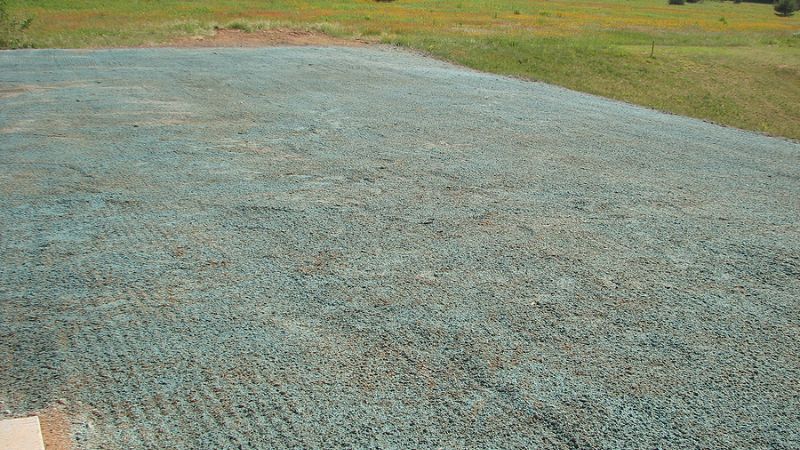What You Need To Know About Hydroseeding
WHAT IS HYDROSEED?
Hydraulic mulch seeding (aka hydroseed) was originally created to spread grass seed onto difficult-to-access slopes in the 1940s. The cost-efficient method then became popular for use on roadsides and commercial properties and has since caught on for residential properties.
Hydroseeding is considered the mid-point in terms of cost, labor, and growth rate when compared to other methods of growing grass, such as sod and seed.
If you want instant grass, then laying sod is the method for you. But you’d better be prepared to pay for it. This is the most expensive of the three methods because you get fully grown grass that you can pretty much walk on immediately. Sod only needs a few weeks to take root. Aside from it’s hefty price tag, sod has limited options for grass seed and can be less hardy (because it is grown and cut and then installed, roots need to really work to become established).
Traditional seeding requires a lot of patience but will save you a lot of money. It can take 6-10 weeks to become fully established enough to walk on. It can also be difficult to get consistent layers of seed across the yard, resulting in bare patches.
Because it requires the same amount of set-up no matter the size of the lawn, you get the most bang for your buck the bigger your yard. That doesn’t mean it’s not a great solution for smaller yards though. It still costs less than sod and grows much quicker than seeding. Hydroseed will start sprouting in 7-10 days, depending on the grass type, and you’ll be mowing in four short weeks!
HOW DOES HYDROSEEDING WORK?
Hydroseeding uses a sprayer to blow a mixture of grass seed, fertilizer, mulch, water, and specific chemicals to create the perfect growing conditions for a new lawn. The fertilizer spurts growth while the mulch bonds the seeds to the soil, provides protection from elements like too much sun or wind, and, eventually, adds nutrients after decomposing.
The spraying method of hydroseeding spreads an even layer of the mixture ensuring a beautifully uniform look.
WHERE TO HYDROSEED?
Hydroseeding is best for large areas of 3,500 sq ft or more, steep slopes that would make other methods of seeding difficult, and areas that need protection from wind, water, or pests that contribute to erosion. The reason these are considered the best places to hydroseed is because of the reduction in labour. Hydroseeding doesn’t require a team of workers to spend multiple hours applying the necessary components by hand. Instead, it takes just a single pass with the sprayer to completely cover the area, no matter how difficult it may be otherwise.
WHEN TO HYDROSEED?
The best time to hydroseed will depend on where you live. Generally, the best seasons for hydroseeding are spring and fall because you get a good combination of warm soil and rain to help seedlings develop deep roots. The summer heat definitely assists with germination and faster growth, but also means you’ll have to water more often. More temperate climates will have longer seasons and more options for when to hydroseed. Colder climates require a more precise and well-timed execution. This is why it’s important to work with a company in your area with lots of experience.
SHOULD I DIY MY HYDROSEEDING?
There are many outside projects that are perfect for DIY. Hydroseeding is not one of them. Hydroseeding services have specialized equipment for mixing the slurry to ensure proper blending. Some of the additives in the mixture require specific licensing in some states — an obvious red light for attempting this on your own. Lastly, the sprayer and other expensive machinery used by experts ensure proper mixing and spraying to guarantee an even application for a beautiful lawn.
HOW DO I MAINTAIN MY LAWN AFTER HYDROSEEDING?
Water. Lots of water. Expect to water a lot the first two to three weeks after hydroseeding. Proper watering is essential for germination. You want to keep moisture in the soil and may need to water several times a day. The professional you work with should leave you with specific instructions that will take into consideration where you live, the soil conditions, the amount of sunlight your yard gets, the weather and any other important factors. If you have a programmable sprinkler, use it. It will save you so much time and money.
Too little water will allow the germinating seed to dry out and die, whereas too much water can create pooling and washouts causing a weak root system.
The process will likely decrease in frequency but increase in duration. Four to six weeks later, your lawn will require approximately 1 to 1.5 inches of water per week, which is pretty standard for most established lawns. Watering less often, but for longer periods will promote deeper rooting.
Mow your new lawn when the grass blades reach 2” to 3” in height, typically around 4-6 weeks after seeding. A good rule of thumb is to mow to a height of 1.5” to 2” whenever possible, however, you want to avoid cutting off more than one-third of the height. If the grass gets too tall, raise your mower’s blade and gradually work back down to the appropriate height over time. Mow frequently, if possible. Mowing helps the plant branch out at its base (these are called tillers). For best practices when mowing a new lawn, keep your blades sharp for a clean-cut and reduce the speed to avoid pulling up seedlings.
Your hydroseed mixture already includes a starter fertilizer, but you should apply a balanced fertilizer (such as 16-16-16 or whatever is recommended by your installer) after the first or second mowing. Fertilize when your lawn is dry and follow with a thorough watering so it doesn’t burn.
You should aim to keep foot traffic off your lawn as much as possible for the first 2-3 months.
Weed seeds in the soil can grow in your lawn, but it’s best to avoid using weed killers for at least three months because they can harm tender grass seedling. If, down the road, you need weed control, follow up with a professional to see what they recommend.
BENEFITS OF HYDROSEEDING
- Cost-effective: For a large area, hydroseeding is less expensive than using sod.
- Quality grass: Hydroseed mixtures can contain customized blends of seed to produce the best formula for where you live.
- Quicker germination: Grass seeds in hydroseed mixes are coated in fertilizer and mulch, which means seed germinate much faster than with other methods.
- Protection: Hydroseed holds moisture better than other methods giving more protection against erosion, wind, rain, and pests.
- Weed prevention: Because hydroseed mixtures include fewer weed seeds and the grass seed germinates quickly, weeds are less likely to pop up.
- Faster application: Professional hydroseeding companies can apply the hydroseed mixture very quickly.
Uniform look: Traditional seeding can sometimes grow in patchy and laying sod creates a grid line look from all the seams. - Healthier looking: Sod can dry out during transportation or between delivery and installation. Hydroseed starts in a moisture-rich environment so all you have to do is maintain it.
- Spring is coming and Bar-b-que season will soon be upon us. How is your yard looking? Could it use a little (or a lot of) sprucing up? A full and luscious lawn will make your time outside next level enjoyable.
To learn more information about the hydroseeding process and how Perfect Images Landscaping LLC can help you, call (803) 747-6669

